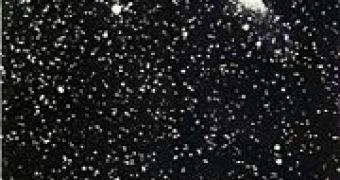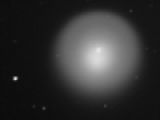Five months after reaching perihelion, Holmes comet produces its second ever observed and recorded outburst in history. The comet has enhanced its brightness about one million times in only a few weeks. Discovered in 1893 by British astronomer Edwin Holmes during a similar outburst, the comet is about 3.3 kilometers across and about 25.000 fainter than the naked eye can see.
The comet is usually invisible on the night sky, but on 23rd October, it has risen from a brightness of 17 magnitude to 2.8 becoming suddenly visible with the naked eye. Observations revealed that a cloud of gas rising from the comet's coma surrounded it and has been expanding at a rate of 0.5 kilometers per second. What triggered the outburst is widely unknown.
The comet has an orbit around the Sun between the planets Mars and Jupiter, which takes seven years to complete. The curious fact is not that the comet has suffered an outburst, but that in its orbit it reached its closest point to the Sun five months ago. Even weirder is that when its first outburst was first discovered and experienced it was in the same place in space as it is now.
The enhanced brightness is due to radiation emitted by the Sun. But it turns out that much more is needed to produce such an effect; as the comet reaches perihelion it doesn't bright up so much and not even other comets that pass even closer to the Sun. An observation using an infrared telescope revealed that the comet is actively releasing gas, mostly composed of water vapour and traces of ethane, acetylene and hydrogen cyanide.
The most popular explanation for the unusual phenomenon is that as it rotates on its axis, a patch of fresh ice from its nucleus was exposed to the solar radiation, causing it to vaporise. The light hitting the vaporised gas and dust reflects off its surface making it shine brightly.
A theory is born from a suggestion that a flattened layer could have been part of the nucleus, broken off and completely disintegrating to produce the spectacular effect; the speculation is partially based on the estimate of the mass of particles in the coma.
Another theory says that gas accumulated in the nucleus over years caused a surface rupture to eliminate the pressure or even that comets are orbited by satellites that occasionally smash into them, to produce an outburst.
Though the comet is on a path that takes it away from the Sun and the fading effect grows bigger, this could as well give some information about the nature of gases eliminated by it. Beyond 3 astronomical units, water can no longer sublimate.
The comet is currently positioned somewhere in the asteroid belt, at a distance of 2.5 astronomical units. If it remains active past the 3 astronomical unit marks, then something more volatile than water is driving its activity.

 14 DAY TRIAL //
14 DAY TRIAL // 
